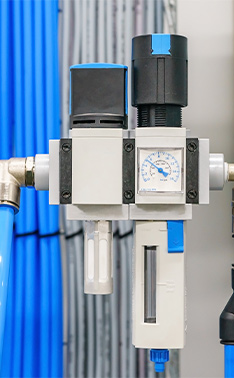What Is An FRL?
Post By: Ryan King On: 25-03-2021 Read Time: 3 minutes - Guides - Pneumatics
Post By: Ryan King On: 25-03-2021 Read Time: 3 minutes - Guides - Pneumatics
An FRL is a combination assembly for your pneumatic system, comprising a filter, a pressure regulator and a lubricator. Even atmospheric air isn't clean, as you can see when you watch dust motes dancing in the sunshine. Once it's been inside a pneumatic compressor, it's also going to be hot, wet, and laced with dirt particles like rust.
Using air in this condition puts your whole system at risk of contamination and damage, which will reduce the life expectancy of its parts. The air travelling downstream from your compressor must therefore be cleaned and lubricated before it reaches any air-driven devices. That’s where your FRL comes in.
FRL is simply shorthand for Filter Regulator Lubricator. While all the individual elements of an FRL unit can be purchased and installed separately, it's more common nowadays for manufacturers to supply them as an all-in-one combination.

The filter is the first stage, cleaning the compressed air after it leaves the compressor. The compressed air passes through the filter, separating out any liquid contaminants such as water or oil, and trapping solid particles like rust, dust and dirt. Filters fall into three general categories: general-purpose filters for removing water and solid particles; coalescing filters specifically for oil; and vapour removal filters to get rid of oil vapour and odour.
General-purpose filters work by centripetal or cyclonic force, spinning the inlet air around and forcing the contaminants downwards, where they collect in a bowl and can be drained off. Coalescing or condensate filters use a particular type of material to attract aerosol and other fine particulates out of the air. These particles coalesce onto the filtration material, until such time as the mass of the accumulated droplets again draws them downwards into a bowl.
The pressure regulator is a special type of valve. It's there to reduce and control the air pressure to the required level for downstream pneumatic equipment to operate most efficiently. The air should be regulated to a constant output pressure, despite any fluctuations in input pressure or demands of the downstream flow. Pressure regulators are commonly available in two types: relieving regulators can reduce the air pressure and automatically exhaust any downstream excess, while non-relieving regulators require an additional exhaust valve.
The function of the lubricator element of the FRL is to put a controlled amount of lubricant into the compressed air once it's been cleaned and regulated, so that downstream components are protected against friction. This lubricant also helps to flush out any compressor oils that remain in the system as oil vapour.
Pre-assembled FRL units are packaged together by manufacturers, categorised by common body sizes and the common sizes of connection ports. The individual parts may be joined together using threaded nipples, or more commonly with modular face connectors. This permits components to be removed more easily for cleaning or servicing. Some manufacturers also design units where the filter and regulator are combined in a stacked assembly, so that the head of the filter becomes the body of the regulator. This type of assembly is very compact, since the major components share inlet and outlet connections in common.
There are several factors to take into account when choosing your FRL unit.
The material of your unit is influenced by its working environment. Industrial environments with exposure to extreme heat or cold, chemicals, or salt, need FRLs made of metal for maximum durability. Less demanding industries can use FRLs made of composite materials such as polycarbonate or nylon.
The capacity of your filter is governed by the maximum size of the particles it filters out. Most applications use a filter with a 5-40 micron rating, but you can get filters as fine as 0.1 micron and even 0.001 micron, for applications such as pharmaceutical or medical.
It is essential to choose an FRL whose airflow capacity is greater than that of the tool which you are going to be using. Check manufacturers' recommendations for the specific requirements of air tools, cylinders, etc, and match your regulator capacity accordingly.
Also, you may not need a three-stage combination for your unit. If you're using self-lubricating air tools, for example, you won't need an additional lubricator element.
You should also make sure the FRL unit connectors match the thread sizes and industry standards of connections on your installation.